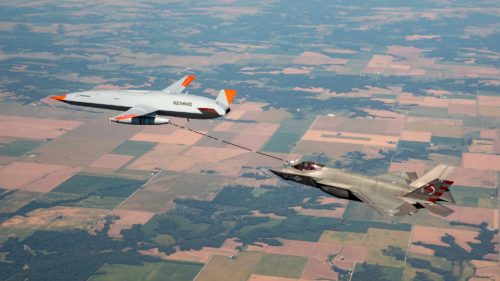Based on information reported by Aviation Week, Boeing has unveiled a new land-based variant of its MQ-25 autonomous tanker. The design, aimed at future U.S. Air Force refueling needs, expands on the U.S. Navy’s carrier-based Stingray model.

Boeing’s land-based MQ-25 boasts a 92-foot wingspan, 17 feet wider than its naval counterpart. This increased span, coupled with the elimination of wing-folding requirements, provides 40% more fuel capacity in the wings.
The MQ-25 land-based variant is specifically designed for operations in contested environments, addressing a critical capability gap in current aerial refueling strategies. These high-threat areas, potentially including regions near peer adversaries, pose significant risks to conventional tankers like the KC-46 due to advanced anti-air systems and long-range missiles.
Boeing’s new design aims to penetrate these dangerous zones, extending the reach of U.S. air power. The autonomous nature of the aircraft reduces the risk to human operators, while its smaller profile may enhance survivability compared to larger tankers.
A key feature of this variant is its potential to refuel Collaborative Combat Aircraft (CCA), the Air Force’s term for autonomous combat drones. This capability could significantly extend CCA mission durations and operational ranges, enhancing their effectiveness in future conflicts. Additionally, the MQ-25 variant maintains compatibility with Navy fighters equipped with probe-and-drogue refueling systems, offering cross-service flexibility.
The aircraft’s ability to be refueled by KC-46 tankers before moving into higher-threat areas creates a tiered refueling strategy. This approach allows the Air Force to project power deeper into contested airspace while keeping more vulnerable assets at safer distances.
John Scudi, Boeing’s acting MQ-25 advanced capabilities program manager, revealed the aircraft could serve multiple roles beyond refueling, including intelligence, surveillance, reconnaissance, airborne early warning, and electronic warfare.
The land-based variant retains the Stingray’s fuselage, mission systems, and Rolls Royce AE 3007N engine. It features two additional 3,000-pound pylon stores, potentially accommodating refueling equipment or weapons systems.
Boeing officials report collaborating with the Air Force on this design, though it’s not directly linked to the ongoing Next-Generation Aerial Refueling System analysis. The unveiling coincides with the Air & Space Forces Association’s Air Space & Cyber Conference.
For more information, hit the Source below